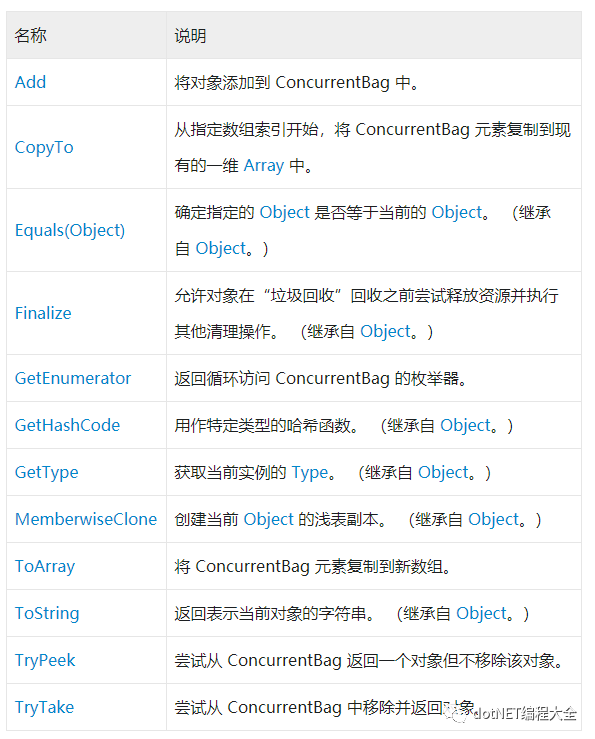C# ConcurrentBag的实现原理

一、前言
笔者最近在做一个项目,项目中为了提升吞吐量,使用了消息队列,中间实现了生产消费模式,在生产消费者模式中需要有一个集合,来存储生产者所生产的物品,笔者使用了最常见的List<T>集合类型。
由于生产者线程有很多个,消费者线程也有很多个,所以不可避免的就产生了线程同步的问题。开始笔者是使用lock关键字,进行线程同步,但是性能并不是特别理想,然后有网友说可以使用SynchronizedList<T>来代替使用List<T>达到线程安全的目的。于是笔者就替换成了SynchronizedList<T>,但是发现性能依旧糟糕,于是查看了SynchronizedList<T>的源代码,发现它就是简单的在List<T>提供的API的基础上加了lock,所以性能基本与笔者实现方式相差无几。
最后笔者找到了解决的方案,使用ConcurrentBag<T>类来实现,性能有很大的改观,于是笔者查看了ConcurrentBag<T>的源代码,实现非常精妙,特此在这记录一下。
二、ConcurrentBag类
ConcurrentBag<T>实现了IProducerConsumerCollection<T>接口,该接口主要用于生产者消费者模式下,可见该类基本就是为生产消费者模式定制的。然后还实现了常规的IReadOnlyCollection<T>类,实现了该类就需要实现IEnumerable<T>、IEnumerable、 ICollection类。
ConcurrentBag<T>对外提供的方法没有List<T>那么多,但是同样有Enumerable实现的扩展方法。类本身提供的方法如下所示。

三、 ConcurrentBag线程安全实现原理
1. ConcurrentBag的私有字段
ConcurrentBag线程安全实现主要是通过它的数据存储的结构和细颗粒度的锁。
public class ConcurrentBag<T> : IProducerConsumerCollection<T>, IReadOnlyCollection<T>{ // ThreadLocalList对象包含每个线程的数据ThreadLocal<ThreadLocalList> m_locals;// 这个头指针和尾指针指向中的第一个和最后一个本地列表,这些本地列表分散在不同线程中// 允许在线程局部对象上枚举volatile ThreadLocalList m_headList, m_tailList;// 这个标志是告知操作线程必须同步操作// 在GlobalListsLock 锁中 设置bool m_needSync;}
首选我们来看它声明的私有字段,其中需要注意的是集合的数据是存放在ThreadLocal线程本地存储中的。也就是说访问它的每个线程会维护一个自己的集合数据列表,一个集合中的数据可能会存放在不同线程的本地存储空间中,所以如果线程访问自己本地存储的对象,那么是没有问题的,这就是实现线程安全的第一层,使用线程本地存储数据。
然后可以看到ThreadLocalList m_headList, m_tailList;这个是存放着本地列表对象的头指针和尾指针,通过这两个指针,我们就可以通过遍历的方式来访问所有本地列表。它使用volatile修饰,所以它是线程安全的。
最后又定义了一个标志,这个标志告知操作线程必须进行同步操作,这是实现了一个细颗粒度的锁,因为只有在几个条件满足的情况下才需要进行线程同步。
2. 用于数据存储的TrehadLocalList类
接下来我们来看一下ThreadLocalList类的构造,该类就是实际存储了数据的位置。实际上它是使用双向链表这种结构进行数据存储。
[]// 构造了双向链表的节点internal class Node{ public Node(T value) {m_value = value;} public readonly T m_value; public Node m_next; public Node m_prev;}/// <summary>/// 集合操作类型/// </summary>internal enum ListOperation{None,Add,Take};/// <summary>/// 线程锁定的类/// </summary>internal class ThreadLocalList{ // 双向链表的头结点 如果为null那么表示链表为空internal volatile Node m_head; // 双向链表的尾节点private volatile Node m_tail; // 定义当前对List进行操作的种类// 与前面的 ListOperation 相对应internal volatile int m_currentOp; // 这个列表元素的计数private int m_count; // The stealing count// 这个不是特别理解 好像是在本地列表中 删除某个Node 以后的计数internal int m_stealCount; // 下一个列表 可能会在其它线程中internal volatile ThreadLocalList m_nextList; // 设定锁定是否已进行internal bool m_lockTaken; // The owner thread for this listinternal Thread m_ownerThread; // 列表的版本,只有当列表从空变为非空统计是底层internal volatile int m_version; /// <summary>/// ThreadLocalList 构造器/// </summary>/// <param name="ownerThread">拥有这个集合的线程</param>internal ThreadLocalList(Thread ownerThread) {m_ownerThread = ownerThread;} /// <summary>/// 添加一个新的item到链表首部/// </summary>/// <param name="item">The item to add.</param>/// <param name="updateCount">是否更新计数.</param>internal void Add(T item, bool updateCount) { checked{m_count++;}Node node = new Node(item); if (m_head == null){Debug.Assert(m_tail == null);m_head = node;m_tail = node;m_version++; // 因为进行初始化了,所以将空状态改为非空状态} else{ // 使用头插法 将新的元素插入链表node.m_next = m_head;m_head.m_prev = node;m_head = node;} if (updateCount) // 更新计数以避免此添加同步时溢出{m_count = m_count - m_stealCount;m_stealCount = 0;}} /// <summary>/// 从列表的头部删除一个item/// </summary>/// <param name="result">The removed item</param>internal void Remove(out T result) { // 双向链表删除头结点数据的流程Debug.Assert(m_head != null);Node head = m_head;m_head = m_head.m_next; if (m_head != null){m_head.m_prev = null;} else{m_tail = null;}m_count--;result = head.m_value;} /// <summary>/// 返回列表头部的元素/// </summary>/// <param name="result">the peeked item</param>/// <returns>True if succeeded, false otherwise</returns>internal bool Peek(out T result) {Node head = m_head; if (head != null){result = head.m_value; return true;}result = default(T); return false;} /// <summary>/// 从列表的尾部获取一个item/// </summary>/// <param name="result">the removed item</param>/// <param name="remove">remove or peek flag</param>internal void Steal(out T result, bool remove) {Node tail = m_tail;Debug.Assert(tail != null); if (remove) // Take operation{m_tail = m_tail.m_prev; if (m_tail != null){m_tail.m_next = null;} else{m_head = null;} // Increment the steal countm_stealCount++;}result = tail.m_value;} /// <summary>/// 获取总计列表计数, 它不是线程安全的, 如果同时调用它, 则可能提供不正确的计数/// </summary>internal int Count{ get{ return m_count - m_stealCount;}}}
从上面的代码中我们可以更加验证之前的观点,就是ConcurentBag<T>在一个线程中存储数据时,使用的是双向链表,ThreadLocalList实现了一组对链表增删改查的方法。
3. ConcurrentBag实现新增元素
接下来我们看一看ConcurentBag<T>是如何新增元素的。
/// <summary>/// 尝试获取无主列表,无主列表是指线程已经被暂停或者终止,但是集合中的部分数据还存储在那里/// 这是避免内存泄漏的方法/// </summary>/// <returns></returns>private ThreadLocalList GetUnownedList(){ //此时必须持有全局锁Contract.Assert(Monitor.IsEntered(GlobalListsLock)); // 从头线程列表开始枚举 找到那些已经被关闭的线程// 将它所在的列表对象 返回ThreadLocalList currentList = m_headList; while (currentList != null){ if (currentList.m_ownerThread.ThreadState == System.Threading.ThreadState.Stopped){currentList.m_ownerThread = Thread.CurrentThread; // the caller should acquire a lock to make this line thread safereturn currentList;}currentList = currentList.m_nextList;} return null;}/// <summary>/// 本地帮助方法,通过线程对象检索线程线程本地列表/// </summary>/// <param name="forceCreate">如果列表不存在,那么创建新列表</param>/// <returns>The local list object</returns>private ThreadLocalList GetThreadList(bool forceCreate){ThreadLocalList list = m_locals.Value; if (list != null){ return list;} else if (forceCreate) { // 获取用于更新操作的 m_tailList 锁lock (GlobalListsLock){ // 如果头列表等于空,那么说明集合中还没有元素// 直接创建一个新的if (m_headList == null){list = new ThreadLocalList(Thread.CurrentThread);m_headList = list;m_tailList = list;} else{ // ConcurrentBag内的数据是以双向链表的形式分散存储在各个线程的本地区域中// 通过下面这个方法 可以找到那些存储有数据 但是已经被停止的线程// 然后将已停止线程的数据 移交到当前线程管理list = GetUnownedList(); // 如果没有 那么就新建一个列表 然后更新尾指针的位置if (list == null){list = new ThreadLocalList(Thread.CurrentThread);m_tailList.m_nextList = list;m_tailList = list;}}m_locals.Value = list;}} else{ return null;}Debug.Assert(list != null); return list;}/// <summary>/// Adds an object to the <see cref="ConcurrentBag{T}"/>./// </summary>/// <param name="item">The object to be added to the/// <see cref="ConcurrentBag{T}"/>. The value can be a null reference/// (Nothing in Visual Basic) for reference types.</param>public void Add(T item){ // 获取该线程的本地列表, 如果此线程不存在, 则创建一个新列表 (第一次调用 add)ThreadLocalList list = GetThreadList(true); // 实际的数据添加操作 在AddInternal中执行AddInternal(list, item);}/// <summary>/// </summary>/// <param name="list"></param>/// <param name="item"></param>private void AddInternal(ThreadLocalList list, T item){ bool lockTaken = false; try{Interlocked.Exchange(ref list.m_currentOp, (int)ListOperation.Add);// 同步案例:// 如果列表计数小于两个, 因为是双向链表的关系 为了避免与任何窃取线程发生冲突 必须获取锁// 如果设置了 m_needSync, 这意味着有一个线程需要冻结包 也必须获取锁if (list.Count < 2 || m_needSync){ // 将其重置为None 以避免与窃取线程的死锁list.m_currentOp = (int)ListOperation.None; // 锁定当前对象Monitor.Enter(list, ref lockTaken);} // 调用 ThreadLocalList.Add方法 将数据添加到双向链表中// 如果已经锁定 那么说明线程安全 可以更新Count 计数list.Add(item, lockTaken);} finally{list.m_currentOp = (int)ListOperation.None; if (lockTaken){Monitor.Exit(list);}}}
从上面代码中,我们可以很清楚的知道Add()方法是如何运行的,其中的关键就是GetThreadList()方法,通过该方法可以获取当前线程的数据存储列表对象,假如不存在数据存储列表,它会自动创建或者通过GetUnownedList()方法来寻找那些被停止但是还存储有数据列表的线程,然后将数据列表返回给当前线程中,防止了内存泄漏。
在数据添加的过程中,实现了细颗粒度的lock同步锁,所以性能会很高。删除和其它操作与新增类似,本文不再赘述。
4. ConcurrentBag 如何实现迭代器模式
看完上面的代码后,我很好奇ConcurrentBag<T>是如何实现IEnumerator来实现迭代访问的,因为ConcurrentBag<T>是通过分散在不同线程中的ThreadLocalList来存储数据的,那么在实现迭代器模式时,过程会比较复杂。
后面再查看了源码之后,发现ConcurrentBag<T>为了实现迭代器模式,将分在不同线程中的数据全都存到一个List<T>集合中,然后返回了该副本的迭代器。所以每次访问迭代器,它都会新建一个List<T>的副本,这样虽然浪费了一定的存储空间,但是逻辑上更加简单了。
/// <summary>/// 本地帮助器方法释放所有本地列表锁/// </summary>private void ReleaseAllLocks(){ // 该方法用于在执行线程同步以后 释放掉所有本地锁// 通过遍历每个线程中存储的 ThreadLocalList对象 释放所占用的锁ThreadLocalList currentList = m_headList; while (currentList != null){ if (currentList.m_lockTaken){currentList.m_lockTaken = false;Monitor.Exit(currentList);}currentList = currentList.m_nextList;}}/// <summary>/// 从冻结状态解冻包的本地帮助器方法/// </summary>/// <param name="lockTaken">The lock taken result from the Freeze method</param>private void UnfreezeBag(bool lockTaken){ // 首先释放掉 每个线程中 本地变量的锁// 然后释放全局锁ReleaseAllLocks();m_needSync = false; if (lockTaken){Monitor.Exit(GlobalListsLock);}}/// <summary>/// 本地帮助器函数等待所有未同步的操作/// </summary>private void WaitAllOperations(){Contract.Assert(Monitor.IsEntered(GlobalListsLock));ThreadLocalList currentList = m_headList; // 自旋等待 等待其它操作完成while (currentList != null){ if (currentList.m_currentOp != (int)ListOperation.None){SpinWait spinner = new SpinWait(); // 有其它线程进行操作时,会将cuurentOp 设置成 正在操作的枚举while (currentList.m_currentOp != (int)ListOperation.None){spinner.SpinOnce();}}currentList = currentList.m_nextList;}}/// <summary>/// 本地帮助器方法获取所有本地列表锁/// </summary>private void AcquireAllLocks(){Contract.Assert(Monitor.IsEntered(GlobalListsLock)); bool lockTaken = false;ThreadLocalList currentList = m_headList;// 遍历每个线程的ThreadLocalList 然后获取对应ThreadLocalList的锁while (currentList != null){ // 尝试/最后 bllock 以避免在获取锁和设置所采取的标志之间的线程港口try{Monitor.Enter(currentList, ref lockTaken);} finally{ if (lockTaken){currentList.m_lockTaken = true;lockTaken = false;}}currentList = currentList.m_nextList;}}/// <summary>/// Local helper method to freeze all bag operations, it/// 1- Acquire the global lock to prevent any other thread to freeze the bag, and also new new thread can be added/// to the dictionary/// 2- Then Acquire all local lists locks to prevent steal and synchronized operations/// 3- Wait for all un-synchronized operations to be done/// </summary>/// <param name="lockTaken">Retrieve the lock taken result for the global lock, to be passed to Unfreeze method</param>private void FreezeBag(ref bool lockTaken){Contract.Assert(!Monitor.IsEntered(GlobalListsLock)); // 全局锁定可安全地防止多线程调用计数和损坏 m_needSyncMonitor.Enter(GlobalListsLock, ref lockTaken); // 这将强制同步任何将来的添加/执行操作m_needSync = true; // 获取所有列表的锁AcquireAllLocks(); // 等待所有操作完成WaitAllOperations();}/// <summary>/// 本地帮助器函数返回列表中的包项, 这主要由 CopyTo 和 ToArray 使用。/// 这不是线程安全, 应该被称为冻结/解冻袋块/// 本方法是私有的 只有使用 Freeze/UnFreeze之后才是安全的 /// </summary>/// <returns>List the contains the bag items</returns>private List<T> ToList(){Contract.Assert(Monitor.IsEntered(GlobalListsLock)); // 创建一个新的ListList<T> list = new List<T>();ThreadLocalList currentList = m_headList; // 遍历每个线程中的ThreadLocalList 将里面的Node的数据 添加到list中while (currentList != null){Node currentNode = currentList.m_head; while (currentNode != null){list.Add(currentNode.m_value);currentNode = currentNode.m_next;}currentList = currentList.m_nextList;} return list;}/// <summary>/// Returns an enumerator that iterates through the <see/// cref="ConcurrentBag{T}"/>./// </summary>/// <returns>An enumerator for the contents of the <see/// cref="ConcurrentBag{T}"/>.</returns>/// <remarks>/// The enumeration represents a moment-in-time snapshot of the contents/// of the bag. It does not reflect any updates to the collection after /// <see cref="GetEnumerator"/> was called. The enumerator is safe to use/// concurrently with reads from and writes to the bag./// </remarks>public IEnumerator<T> GetEnumerator(){ // Short path if the bag is emptyif (m_headList == null) return new List<T>().GetEnumerator(); // empty listbool lockTaken = false; try{ // 首先冻结整个 ConcurrentBag集合FreezeBag(ref lockTaken); // 然后ToList 再拿到 List的 IEnumeratorreturn ToList().GetEnumerator();} finally{UnfreezeBag(lockTaken);}}
由上面的代码可知道,为了获取迭代器对象,总共进行了三步主要的操作。
使用FreezeBag()方法,冻结整个ConcurrentBag<T>集合。因为需要生成集合的List<T>副本,生成副本期间不能有其它线程更改损坏数据。将ConcurrrentBag<T>生成List<T>副本。因为ConcurrentBag<T>存储数据的方式比较特殊,直接实现迭代器模式困难,考虑到线程安全和逻辑,最佳的办法是生成一个副本。完成以上操作以后,就可以使用UnfreezeBag()方法解冻整个集合。
那么FreezeBag()方法是如何来冻结整个集合的呢?也是分为三步走。
首先获取全局锁,通过Monitor.Enter(GlobalListsLock, ref lockTaken);这样一条语句,这样其它线程就不能冻结集合。然后获取所有线程中ThreadLocalList的锁,通过`AcquireAllLocks()方法来遍历获取。这样其它线程就不能对它进行操作损坏数据。等待已经进入了操作流程线程结束,通过WaitAllOperations()方法来实现,该方法会遍历每一个ThreadLocalList对象的m_currentOp属性,确保全部处于None操作。
完成以上流程后,那么就是真正的冻结了整个ConcurrentBag<T>集合,要解冻的话也类似。在此不再赘述。
四、总结
下面给出一张图,描述了ConcurrentBag<T>是如何存储数据的。通过每个线程中的ThreadLocal来实现线程本地存储,每个线程中都有这样的结构,互不干扰。然后每个线程中的m_headList总是指向ConcurrentBag<T>的第一个列表,m_tailList指向最后一个列表。列表与列表之间通过m_locals 下的 m_nextList相连,构成一个单链表。
数据存储在每个线程的m_locals中,通过Node类构成一个双向链表。
PS: 要注意m_tailList和m_headList并不是存储在ThreadLocal中,而是所有的线程共享一份。

.NET Core实战项目之CMS 第一章 入门篇-开篇及总体规划
【.NET Core微服务实战-统一身份认证】开篇及目录索引
Redis基本使用及百亿数据量中的使用技巧分享(附视频地址及观看指南)
.NET Core中的一个接口多种实现的依赖注入与动态选择看这篇就够了
用abp vNext快速开发Quartz.NET定时任务管理界面
